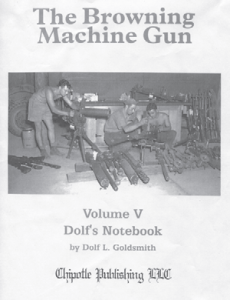Review by Jim Dickson THE BROWNING MACHINE GUN, Volume V, Dolf’s Notebook, by Dolf Goldsmith. © 2013. 306
pages, hardcover.
Price: $59.95 plus $8.95 shipping from Chipotle Publishing LLC, 631 N.
Stephanie St. #372, Henderson, NV 89014; phone: 702-565-0746.
The fifth volume of Dolf Goldsmith’s monumental work on the Browning machinegun (BMG) is by far the most important as it goes into great detail on all the problems encountered with the gun and their cures. Not only the American solutions to problems are covered, but the innovative solutions of Sweden, Britain, Belgium, and Israel are shown.
It is the author’s hope that if the Browning machinegun goes back into production that this book will enable the manufacturer to sidestep many of the problems that have plagued this gun.
The problems of headspace and timing and their simple solutions are covered here yet these proved such a problem for the military to train men to handle that they were instrumental in the Browning being withdrawn from service. Another potentially lethal flaw was the large numbers made without the driving spring and its guide rod being made as a captive unit. When it is not captive it can launch the guide rod like a bolt from a crossbow during disassembly if you aren’t very careful. Men have been seriously injured and some blinded by this preventable catastrophe.
Troubleshooting the gun and inspecting the parts for wear and damage before they can fail in service is covered in detail. This is vital as most parts in the gun have a life of 40,000-100,000 rounds. The Browning will begin to fail after 40,000 to 50,000 rounds in service, requiring repair and it must be disassembled to get to the respective parts to replace them. You had better know which parts and how to fix them also. This book covers every detail any ordnance man will ever need to know. Obviously barrels are constantly being changed on any machinegun but the Browning must be headspaced before firing. Hardly a quick change system! Contrast this with the WW1 Maxim machinegun that was capable of firing into the millions of rounds without a parts breakage, requiring only a new barrel and more water in the jacket on a regular basis. A modular design, the Maxim gunner simply changed out the lock, feedblock, or fusee spring assembly if a part failed and sent the broken unit back for ordnance to deal with.
The intricate details of every phase of operating the gun as well as repair and rebuilding are fully covered here in clear concise language that is easily understood by anyone. You will see every possible problem that can be encountered with this gun and its solution. This is far superior to any manual ever published on the BMG as it is far more comprehensive.
Development history of some of the improvements is detailed so that the reader gets an in-depth knowledge of important factors that are glossed over in other manuals.
The Browning machine gun required more training than other designs to avoid problems and this training was often not up to standards as evidenced by the problems encountered in using it in the field. Every soldier that may come in contact with a BMG should have this book and for the owner of a BMG it is absolutely indispensible. If you are only going to have one book or manual on the BMG, it should be this one. This is the last word on keeping the BMG firing.




